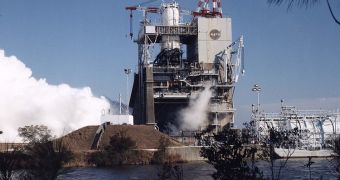Officials at the American space agency announce that experts at the John C. Stennis Space Center (SSC), in Mississippi, have conducted a new rocket engine test yesterday, November 10, in order to assess the performances of a private booster engine developed by Orbital Sciences Corporation (OSC).
The liquid-fuel AJ26 engine is destined to go on the OSC Taurus II delivery system, which the corporation is developing to gain access to low-Earth Orbit. OSC is working with a NASA grant in developing the rocket.
Under the COTS program, Hawthorne, California-based Space Exploration Technologies Corporation (SpaceX) and OSC receive billions of dollars to develop replacement spacecrafts and related delivery systems for allowing US astronauts access to the International Space Station in the coming years.
The new engine test was a part of those efforts, researchers say. The motor itself was supplied by OSC and its engine supplier Aerojet, and was tested with direct engineering and infrastructure support from the space agency.
On Wednesday, the engine was ignited for only 10 seconds, but this gave scientists ample time to collect a wide array of critical readings, that are very important in determining how the device will function in real life.
This is only the first of three similar tests, which are meant to verify AJ26 engine start and shutdown sequences, in addition to test stand operations, and ground-test engine controls, NASA reports.
“Congratulations to Orbital and Aerojet for successfully completing another major milestone. This brings us one step closer to realizing NASA's goals for accessing low Earth orbit via commercial spacecraft,” says Doug Cooke.
He is the associate administrator for the Exploration Systems Mission Directorate at the NASA Headquarters, in Washington DC. Stennis, OSC, and Aerojet engineers worked together to bring the engine to life.
“With this first test, Stennis not only demonstrates its versatility and status as the nation's premiere rocket engine test facility, it also opens an exciting new chapter in the nation's space program,” explains the director of the Stennis Center, Patrick Scheuermann.
“We're proud to be partnering with Orbital to enable the wave of the future – commercial flights to space and eventual resupply of cargo to the International Space Station,” the NASA official adds.
Stennis has not been host of rocket engine tests in years. In order to accommodate the AJ26 assessment, the E-1 test stand had to undergo significant modifications, which took about two years to complete.

 14 DAY TRIAL //
14 DAY TRIAL //